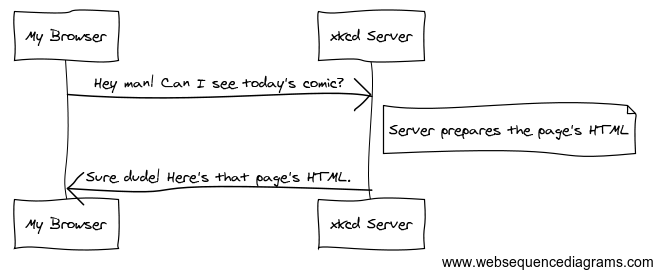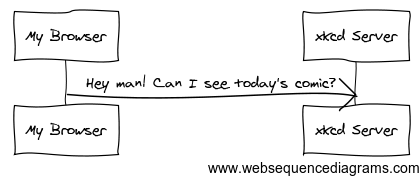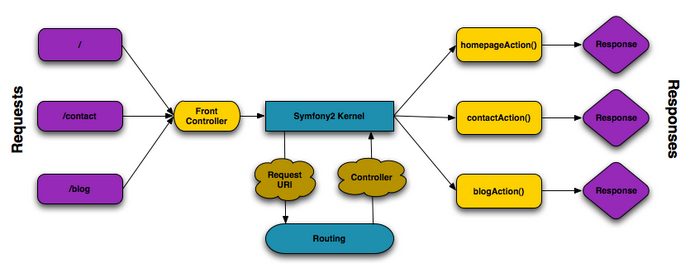Symfony和HTTP基础工具
发布于 2015-08-27 16:27:07 | 382 次阅读 | 评论: 0 | 来源: 网络整理
Congratulations! By learning about Symfony, you’re well on your way towards being a more productive, well-rounded and popular web developer (actually, you’re on your own for the last part). Symfony is built to get back to basics: to develop tools that let you develop faster and build more robust applications, while staying out of your way. Symfony is built on the best ideas from many technologies: the tools and concepts you’re about to learn represent the efforts of thousands of people, over many years. In other words, you’re not just learning “Symfony”, you’re learning the fundamentals of the web, development best practices and how to use many amazing new PHP libraries, inside or independently of Symfony. So, get ready.
True to the Symfony philosophy, this chapter begins by explaining the fundamental concept common to web development: HTTP. Regardless of your background or preferred programming language, this chapter is a must-read for everyone.
HTTP很简单¶
HTTP (Hypertext Transfer Protocol to the geeks) is a text language that allows two machines to communicate with each other. That’s it! For example, when checking for the latest xkcd comic, the following (approximate) conversation takes place:

And while the actual language used is a bit more formal, it’s still dead-simple. HTTP is the term used to describe this simple text-based language. No matter how you develop on the web, the goal of your server is always to understand simple text requests, and return simple text responses.
Symfony is built from the ground up around that reality. Whether you realize it or not, HTTP is something you use every day. With Symfony, you’ll learn how to master it.
第一步:客户端发出请求¶
Every conversation on the web starts with a request. The request is a text message created by a client (e.g. a browser, a smartphone app, etc) in a special format known as HTTP. The client sends that request to a server, and then waits for the response.
Take a look at the first part of the interaction (the request) between a browser and the xkcd web server:

In HTTP-speak, this HTTP request would actually look something like this:
GET / HTTP/1.1 Host: xkcd.com Accept: text/html User-Agent: Mozilla/5.0 (Macintosh)
This simple message communicates everything necessary about exactly which resource the client is requesting. The first line of an HTTP request is the most important and contains two things: the URI and the HTTP method.
The URI (e.g. /, /contact, etc) is the unique address or location that identifies the resource the client wants. The HTTP method (e.g. GET) defines what you want to do with the resource. The HTTP methods are the verbs of the request and define the few common ways that you can act upon the resource:
| GET | Retrieve the resource from the server |
| POST | Create a resource on the server |
| PUT | Update the resource on the server |
| DELETE | Delete the resource from the server |
With this in mind, you can imagine what an HTTP request might look like to delete a specific blog entry, for example:
DELETE /blog/15 HTTP/1.1
注解
There are actually nine HTTP methods defined by the HTTP specification, but many of them are not widely used or supported. In reality, many modern browsers don’t even support the PUT and DELETE methods.
In addition to the first line, an HTTP request invariably contains other lines of information called request headers. The headers can supply a wide range of information such as the requested Host, the response formats the client accepts (Accept) and the application the client is using to make the request (User-Agent). Many other headers exist and can be found on Wikipedia’s List of HTTP header fields article.
第二步:服务端返回响应¶
Once a server has received the request, it knows exactly which resource the client needs (via the URI) and what the client wants to do with that resource (via the method). For example, in the case of a GET request, the server prepares the resource and returns it in an HTTP response. Consider the response from the xkcd web server:

Translated into HTTP, the response sent back to the browser will look something like this:
HTTP/1.1 200 OK Date: Sat, 02 Apr 2011 21:05:05 GMT Server: lighttpd/1.4.19 Content-Type: text/html <html> <!-- ... HTML for the xkcd comic --> </html>
The HTTP response contains the requested resource (the HTML content in this case), as well as other information about the response. The first line is especially important and contains the HTTP response status code (200 in this case). The status code communicates the overall outcome of the request back to the client. Was the request successful? Was there an error? Different status codes exist that indicate success, an error, or that the client needs to do something (e.g. redirect to another page). A full list can be found on Wikipedia’s List of HTTP status codes article.
Like the request, an HTTP response contains additional pieces of information known as HTTP headers. For example, one important HTTP response header is Content-Type. The body of the same resource could be returned in multiple different formats like HTML, XML, or JSON and the Content-Type header uses Internet Media Types like text/html to tell the client which format is being returned. A list of common media types can be found on Wikipedia’s List of common media types article.
Many other headers exist, some of which are very powerful. For example, certain headers can be used to create a powerful caching system.
Requests, Responses和Web开发¶
This request-response conversation is the fundamental process that drives all communication on the web. And as important and powerful as this process is, it’s inescapably simple.
The most important fact is this: regardless of the language you use, the type of application you build (web, mobile, JSON API) or the development philosophy you follow, the end goal of an application is always to understand each request and create and return the appropriate response.
Symfony is architected to match this reality.
小技巧
To learn more about the HTTP specification, read the original HTTP 1.1 RFC or the HTTP Bis, which is an active effort to clarify the original specification. A great tool to check both the request and response headers while browsing is the Live HTTP Headers extension for Firefox.
PHP里的请求和响应¶
So how do you interact with the “request” and create a “response” when using PHP? In reality, PHP abstracts you a bit from the whole process:
$uri = $_SERVER['REQUEST_URI'];
$foo = $_GET['foo'];
header('Content-Type: text/html');
echo 'The URI requested is: '.$uri;
echo 'The value of the "foo" parameter is: '.$foo;
As strange as it sounds, this small application is in fact taking information from the HTTP request and using it to create an HTTP response. Instead of parsing the raw HTTP request message, PHP prepares superglobal variables such as $_SERVER and $_GET that contain all the information from the request. Similarly, instead of returning the HTTP-formatted text response, you can use the header() function to create response headers and simply print out the actual content that will be the content portion of the response message. PHP will create a true HTTP response and return it to the client:
HTTP/1.1 200 OK Date: Sat, 03 Apr 2011 02:14:33 GMT Server: Apache/2.2.17 (Unix) Content-Type: text/html The URI requested is: /testing?foo=symfony The value of the "foo" parameter is: symfony
Symfony里的请求和响应¶
Symfony provides an alternative to the raw PHP approach via two classes that allow you to interact with the HTTP request and response in an easier way. The Request class is a simple object-oriented representation of the HTTP request message. With it, you have all the request information at your fingertips:
use SymfonyComponentHttpFoundationRequest;
$request = Request::createFromGlobals();
// the URI being requested (e.g. /about) minus any query parameters
$request->getPathInfo();
// retrieve GET and POST variables respectively
$request->query->get('foo');
$request->request->get('bar', 'default value if bar does not exist');
// retrieve SERVER variables
$request->server->get('HTTP_HOST');
// retrieves an instance of UploadedFile identified by foo
$request->files->get('foo');
// retrieve a COOKIE value
$request->cookies->get('PHPSESSID');
// retrieve an HTTP request header, with normalized, lowercase keys
$request->headers->get('host');
$request->headers->get('content_type');
$request->getMethod(); // GET, POST, PUT, DELETE, HEAD
$request->getLanguages(); // an array of languages the client accepts
As a bonus, the Request class does a lot of work in the background that you’ll never need to worry about. For example, the isSecure() method checks the three different values in PHP that can indicate whether or not the user is connecting via a secured connection (i.e. HTTPS).
ParameterBags and Request Attributes
As seen above, the $_GET and $_POST variables are accessible via the public query and request properties respectively. Each of these objects is a ParameterBag object, which has methods like get(), has(), all() and more. In fact, every public property used in the previous example is some instance of the ParameterBag.
The Request class also has a public attributes property, which holds special data related to how the application works internally. For the Symfony framework, the attributes holds the values returned by the matched route, like _controller, id (if you have an {id} wildcard), and even the name of the matched route (_route). The attributes property exists entirely to be a place where you can prepare and store context-specific information about the request.
Symfony also provides a Response class: a simple PHP representation of an HTTP response message. This allows your application to use an object-oriented interface to construct the response that needs to be returned to the client:
use SymfonyComponentHttpFoundationResponse;
$response = new Response();
$response->setContent('<html><body><h1>Hello world!</h1></body></html>');
$response->setStatusCode(Response::HTTP_OK);
$response->headers->set('Content-Type', 'text/html');
// prints the HTTP headers followed by the content
$response->send();
If Symfony offered nothing else, you would already have a toolkit for easily accessing request information and an object-oriented interface for creating the response. Even as you learn the many powerful features in Symfony, keep in mind that the goal of your application is always to interpret a request and create the appropriate response based on your application logic.
小技巧
The Request and Response classes are part of a standalone component included with Symfony called HttpFoundation. This component can be used entirely independently of Symfony and also provides classes for handling sessions and file uploads.
从Request到Response的旅程¶
Like HTTP itself, the Request and Response objects are pretty simple. The hard part of building an application is writing what comes in between. In other words, the real work comes in writing the code that interprets the request information and creates the response.
Your application probably does many things, like sending emails, handling form submissions, saving things to a database, rendering HTML pages and protecting content with security. How can you manage all of this and still keep your code organized and maintainable?
Symfony was created to solve these problems so that you don’t have to.
The Front Controller¶
Traditionally, applications were built so that each “page” of a site was its own physical file:
index.php contact.php blog.php
There are several problems with this approach, including the inflexibility of the URLs (what if you wanted to change blog.php to news.php without breaking all of your links?) and the fact that each file must manually include some set of core files so that security, database connections and the “look” of the site can remain consistent.
A much better solution is to use a front controller: a single PHP file that handles every request coming into your application. For example:
/index.php |
executes index.php |
/index.php/contact |
executes index.php |
/index.php/blog |
executes index.php |
小技巧
Using Apache’s mod_rewrite (or equivalent with other web servers), the URLs can easily be cleaned up to be just /, /contact and /blog.
Now, every request is handled exactly the same way. Instead of individual URLs executing different PHP files, the front controller is always executed, and the routing of different URLs to different parts of your application is done internally. This solves both problems with the original approach. Almost all modern web apps do this - including apps like WordPress.
保持条理清晰¶
Inside your front controller, you have to figure out which code should be executed and what the content to return should be. To figure this out, you’ll need to check the incoming URI and execute different parts of your code depending on that value. This can get ugly quickly:
// index.php
use SymfonyComponentHttpFoundationRequest;
use SymfonyComponentHttpFoundationResponse;
$request = Request::createFromGlobals();
$path = $request->getPathInfo(); // the URI path being requested
if (in_array($path, array('', '/'))) {
$response = new Response('Welcome to the homepage.');
} elseif ('/contact' === $path) {
$response = new Response('Contact us');
} else {
$response = new Response('Page not found.', Response::HTTP_NOT_FOUND);
}
$response->send();
Solving this problem can be difficult. Fortunately it’s exactly what Symfony is designed to do.
Symfony应用的运行流程¶
When you let Symfony handle each request, life is much easier. Symfony follows the same simple pattern for every request:

Incoming requests are interpreted by the routing and passed to controller functions that return Response objects.
Each “page” of your site is defined in a routing configuration file that maps different URLs to different PHP functions. The job of each PHP function, called a controller, is to use information from the request - along with many other tools Symfony makes available - to create and return a Response object. In other words, the controller is where your code goes: it’s where you interpret the request and create a response.
It’s that easy! To review:
- Each request executes a front controller file;
- The routing system determines which PHP function should be executed based on information from the request and routing configuration you’ve created;
- The correct PHP function is executed, where your code creates and returns the appropriate
Responseobject.
Symfony请求处理示例¶
Without diving into too much detail, here is this process in action. Suppose you want to add a /contact page to your Symfony application. First, start by adding an entry for /contact to your routing configuration file:
- YAML
# app/config/routing.yml contact: path: /contact defaults: { _controller: AppBundle:Main:contact } - XML
<!-- app/config/routing.xml --> <?xml version="1.0" encoding="UTF-8" ?> <routes xmlns="http://symfony.com/schema/routing" xmlns:xsi="http://www.w3.org/2001/XMLSchema-instance" xsi:schemaLocation="http://symfony.com/schema/routing http://symfony.com/schema/routing/routing-1.0.xsd"> <route id="contact" path="/contact"> <default key="_controller">AppBundle:Main:contact</default> </route> </routes> - PHP
// app/config/routing.php use SymfonyComponentRoutingRoute; use SymfonyComponentRoutingRouteCollection; $collection = new RouteCollection(); $collection->add('contact', new Route('/contact', array( '_controller' => 'AppBundle:Main:contact', ))); return $collection;
When someone visits the /contact page, this route is matched, and the specified controller is executed. As you’ll learn in the routing chapter, the AppBundle:Main:contact string is a short syntax that points to a specific PHP method contactAction inside a class called MainController:
// src/AppBundle/Controller/MainController.php
namespace AppBundleController;
use SymfonyComponentHttpFoundationResponse;
class MainController
{
public function contactAction()
{
return new Response('<h1>Contact us!</h1>');
}
}
In this very simple example, the controller simply creates a Response object with the HTML <h1>Contact us!</h1>. In the controller chapter, you’ll learn how a controller can render templates, allowing your “presentation” code (i.e. anything that actually writes out HTML) to live in a separate template file. This frees up the controller to worry only about the hard stuff: interacting with the database, handling submitted data, or sending email messages.
Symfony:专注项目本身,而不是工具¶
You now know that the goal of any app is to interpret each incoming request and create an appropriate response. As an application grows, it becomes more difficult to keep your code organized and maintainable. Invariably, the same complex tasks keep coming up over and over again: persisting things to the database, rendering and reusing templates, handling form submissions, sending emails, validating user input and handling security.
The good news is that none of these problems is unique. Symfony provides a framework full of tools that allow you to build your application, not your tools. With Symfony, nothing is imposed on you: you’re free to use the full Symfony framework, or just one piece of Symfony all by itself.
独立的工具箱: Symfony 组件¶
So what is Symfony? First, Symfony is a collection of over twenty independent libraries that can be used inside any PHP project. These libraries, called the Symfony Components, contain something useful for almost any situation, regardless of how your project is developed. To name a few:
- HttpFoundation
- Contains the
RequestandResponseclasses, as well as other classes for handling sessions and file uploads. - Routing
- Powerful and fast routing system that allows you to map a specific URI (e.g.
/contact) to some information about how that request should be handled (e.g. execute thecontactAction()method). - Form
- A full-featured and flexible framework for creating forms and handling form submissions.
- Validator
- A system for creating rules about data and then validating whether or not user-submitted data follows those rules.
- Templating
- A toolkit for rendering templates, handling template inheritance (i.e. a template is decorated with a layout) and performing other common template tasks.
- Security
- A powerful library for handling all types of security inside an application.
- Translation
- A framework for translating strings in your application.
Each one of these components is decoupled and can be used in any PHP project, regardless of whether or not you use the Symfony framework. Every part is made to be used if needed and replaced when necessary.
全方位解决方案: Symfony 框架¶
So then, what is the Symfony Framework? The Symfony Framework is a PHP library that accomplishes two distinct tasks:
- Provides a selection of components (i.e. the Symfony Components) and third-party libraries (e.g. Swift Mailer for sending emails);
- Provides sensible configuration and a “glue” library that ties all of these pieces together.
The goal of the framework is to integrate many independent tools in order to provide a consistent experience for the developer. Even the framework itself is a Symfony bundle (i.e. a plugin) that can be configured or replaced entirely.
Symfony provides a powerful set of tools for rapidly developing web applications without imposing on your application. Normal users can quickly start development by using a Symfony distribution, which provides a project skeleton with sensible defaults. For more advanced users, the sky is the limit.